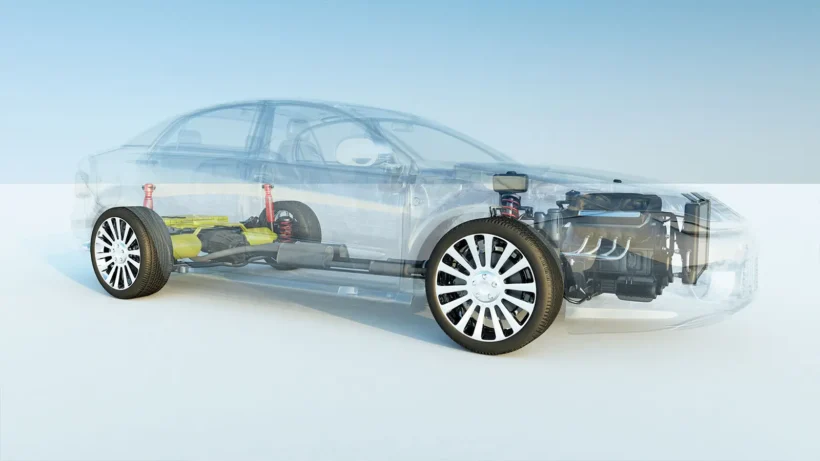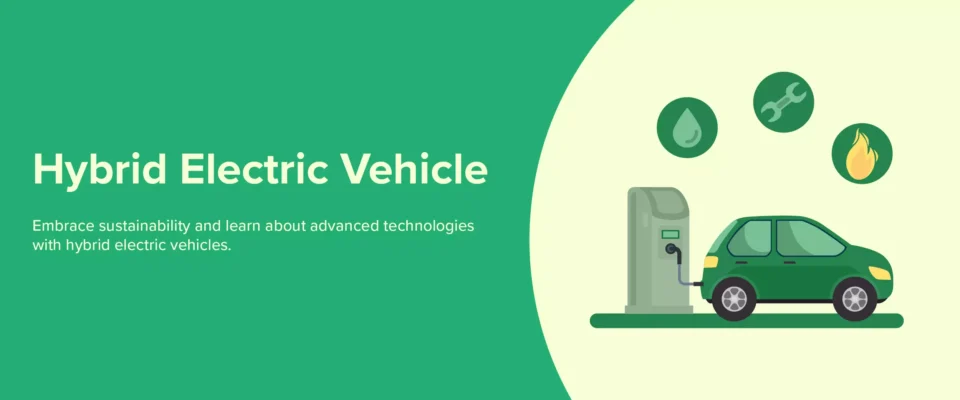Hybrid electric vehicles (HEVs) combine a conventional internal combustion engine with an electric propulsion system to achieve better fuel economy and reduce emissions. Hybrids are becoming a popular eco-friendly automotive choice for many consumers.
What are HEVs?

HEVs contain both an internal combustion engine and electric motor(s). The gasoline engine provides power to the wheels alongside the electric motor which uses energy stored in batteries.
The hybrid system determines optimal power delivery from the engine and motor based on driving conditions. Regenerative braking helps recharge the batteries.
Types of HEVs
There are two main types of hybrid drivetrains:
Series hybrid – The combustion engine acts as a generator to produce electricity that powers an electric motor which drives the wheels. Example: BMW i3 REx
Parallel hybrid – Both the engine and electric motor can directly provide propulsive power to run the wheels via mechanical linkage. Example: Toyota Prius
Some hybrids also have plug-in capability to recharge from an external electric source. These are called plug-in hybrid electric vehicles (PHEVs).
How Do HEVs Work?

Hybrids utilize a variety of strategies to utilize both power sources efficiently:
- The electric motor provides initial launch power and assists during acceleration. This allows using a smaller engine.
- The engine takes over cruising duty once at speed. This saves battery charge for stop-start driving use.
- Regenerative braking converts kinetic energy to electric energy when decelerating, improving efficiency.
- Idle-stop capability turns the engine off when idle to prevent wastage and restart instantly.
- Excess engine power is used to generate electricity for recharging the battery pack.
- Sophisticated control systems switch seamlessly between power sources depending on conditions.
Benefits of HEVs
Hybrids offer many benefits compared to conventional petrol-only vehicles:
- Improved fuel efficiency– HEVs can achieve 25-80% higher mileage depending on battery assist and regenerative braking.
- Reduced emissions– Lower fuel consumption directly cuts greenhouse gas emissions. Some HEVs can run on electric-only mode for short distances.
- Financial savings– The fuel cost savings offset the higher upfront cost over time. Government incentives can further reduce purchasing costs.
- Enhanced performance– Instant torque from the electric motor provides faster acceleration. Dual power sources allow using a smaller, more efficient engine.
- Regenerative braking– Kinetic energy recovery during deceleration improves overall efficiency by recharging the battery.
HEVs vs. Non-Hybrid Models: A Comparison

| Parameter | Hybrid Vehicle | Non-Hybrid Vehicle |
| Fuel efficiency | 25-80% higher | Lower MPG |
| Carbon emissions | 30-60% lower | Higher emissions |
| Purchase cost | $3,000-$12,000 more | Lower MSRP without electrification |
| Maintenance cost | Comparable overall | No hybrid components to maintain |
| Performance | Faster acceleration and responsiveness | Slower acceleration without electric boost |
| Components | More complex with dual powertrain | Simpler mechanical systems |
In summary, HEVs achieve significant gains in fuel efficiency and emissions but cost more upfront. The tradeoff balances out over years of fuel savings. Performance is also enhanced.
Environmental Impact of Hybrid Cars
Hybrid vehicles play an important role in reducing the environmental footprint of personal transportation thanks to substantially improved fuel efficiency and lower emissions compared to conventional petrol cars.
Hybrid Cars and the Environment
Hybrid technology is one of the most effective ways to reduce the environmental impact of existing vehicles that still rely on internal combustion engines. The electrification helps make fossil fuel use more efficient.
Studies by EPA and other agencies consistently show hybrids emitting significantly less air pollutants like greenhouse gases, carbon monoxide and particulate matter. Widespread adoption can, therefore, help tackle climate change and improve air quality.
Carbon Footprint of Hybrid Cars

Hybrid cars produce 24-62% less carbon dioxide over their lifetime compared to equivalent petrol-only models as per various environmental agency estimates.
For example, a typical mid-size hybrid emits around 4 metric tons of CO2 annually versus 6-11 tons for a non-hybrid according to Union of Concerned Scientists.
How Hybrid Cars Reduce Emissions
Hybrid cars lower emissions through:
- Higher fuel efficiency– Less fuel burned directly translates to lower emissions. HEVs can achieve 25-80% more miles per gallon.
- Electric motor assistance– Some driving can happen on electric-only mode producing zero direct emissions.
- Regenerative braking– Kinetic energy is recaptured instead of lost as heat during braking.
- Idle stop-start– Engine shuts off when idle to prevent wasteful emissions. Restarts instantly when needed.
- Smaller engine– The dual powertrain allows utilizing a more efficient, lower displacement engine.
Hybrid Cars vs. Electric Cars: A Comparison
While hybrids offer substantial eco-benefits compared to petrol cars, all-electric vehicles are still cleaner with zero tailpipe emissions:
| Aspect | Hybrid Car | Electric Car |
| Tailpipe emissions | Lower | Zero |
| Well-to-wheel emissions | Lower | Zero if renewable energy source |
| MPG equivalent | 50-80 mpg | 90-120 mpge |
| Driving range | 300-600 miles | 75-350 miles |
| Convenience | Quicker refueling | Longer charge times |
However, hybrids may make more sense for long distance driving needs today given current EV range limitations.
The Future of Hybrid Cars and the Environment
Hybrid cars serve as a bridge to a more sustainable future. As battery costs keep decreasing, plug-in hybrids will become more popular, offering electric convenience for shorter trips while retaining long-range flexibility.
With more renewable electricity on grids, hybrids and EVs will keep reducing transport related carbon emissions and improving urban air quality in the coming decades.
Top Eco-Friendly Innovations in Hybrid Cars
Hybrid cars leverage a range of cutting-edge technologies to minimize their fuel consumption and environmental impact beyond just engine-motor integration.
Introduction to Eco-Friendly Innovations in Hybrid Cars

Hybrid vehicles achieve their high fuel efficiency through an intelligent combination of electric and gasoline propulsion. But they also utilize many other eco-focused design and technology innovations.
These complementary advancements help further enhance the environmental benefits and sustainability of hybrids.
Regenerative Braking
Kinetic energy is recaptured when decelerating instead of being wasted as heat. This charges the battery and improves overall efficiency by up to 10%.
Solar Panels
Some hybrids like the Toyota Prius have solar roofs that trickle charge the battery. This can power climate control and other electrical systems without tapping the battery.
Lightweight Materials
Lighter materials like aluminum and carbon fiber reduce weight which directly lowers fuel consumption. A 10% weight reduction can improve fuel economy by 6-8%.
Aerodynamic Design
Sleek, low-drag designs allow cutting through air using less energy. Improved aerodynamics can enhance fuel efficiency by 3-5% on highways.
Comparison of Eco-Friendly Innovations in Hybrid Cars
| Innovation | Benefits |
| Regenerative Braking | Uses momentum to recharge battery. Up to 10% efficiency gain. |
| Solar Panels | Trickle charges battery using free solar energy. Reduces load on engine. |
| Lightweight Materials | Lower weight decreases rolling resistance and energy usage. Each 10% weight reduction improves MPG by 6-8%. |
| Aerodynamic Design | Reduces air resistance at higher speeds. Can improve MPG by 3-5% on highways. |
These complementary technologies work together with the hybrid powertrain to maximize efficiency and minimize the eco-footprint.
Choosing the Right Hybrid Car
Hybrid cars come in many shapes and sizes to meet a range of needs. Here are some factors to consider when choosing the right hybrid vehicle.
Factors to Consider When Choosing a Hybrid Car

Budget – Hybrids cover a wide spectrum from compact sedans to luxury SUVs. Prices range from low $20,000s to over $100,000.
Performance needs – Some hybrids focus on efficiency while others balance power and range. Consider acceleration and cargo/passenger capacity.
Driving habits – Frequent start-stop city driving maximizes hybrid benefits. More highway driving favors diesel or EVs.
Charging access – For plug-in hybrids, ensure home or workplace charging availability.
Climate conditions – Cold weather saps EV battery range. Consider all-wheel-drive hybrids if living in snowy regions.
Incentives – Factor in potential tax credits, HOV lane access and other incentives where offered.
Types of Hybrid Cars
Compact sedans – Examples include Toyota Prius, Honda Insight. Great efficiency and practicality but limited cargo space.
Midsize sedans – Toyota Camry, Hyundai Sonata. Comfortable, roomy family cars balancing economy and space.
SUVs – Ford Escape, Toyota Highlander. Hybrid capability combined with cargo versatility and AWD options.
Luxury vehicles – Lexus, BMW, Mercedes. Premium features, performance and status along with hybrid fuel savings.
Performance hybrids – Sports cars like Acura NSX integrate electric torque for blistering speed along with efficiency.
Fuel Efficiency and Range
Fuel economy for hybrids ranges from 50-60 mpg for compact economy models to 25-35 mpg for luxury SUV hybrids. Overall driving range is 300-600 miles similar to petrol vehicles.
Plug-in hybrids offer 15-50 mile electric range before the gas engine kicks in allowing shorter all-electric commuting.
Safety Features
Most hybrids offer standard advanced safety aids like collision warning, blind spot monitoring, lane keep assist, adaptive cruise control, automatic emergency braking etc.
Larger hybrids provide greater occupant protection in crashes compared to smaller eco-focused models.
Cost and Incentives
Hybrids typically cost $3000-$12,000 more than equivalent non-hybrid versions. Tax credits of up to $7500, HOV access and additional state incentives can help offset costs.
Fuel savings of $1500 or more annually over petrol-only cars balance out the premium over 5-10 years ownership.
Maintenance and Safety of Hybrid Cars

Hybrid components require specialized maintenance expertise. But following recommended practices and precautions can help ensure safe, reliable operation.
Maintenance of Hybrid Cars
Hybrid maintenance is comparable to conventional cars for most routine servicing of fluids, filters, tires, brakes etc. Unique aspects involve:
- Battery pack– No scheduled maintenance needed. Cooling systems may require infrequent service.
- Motors– Electric motors are brushless and maintenance-free. Inverters may need service over 10-15 years.
- Regenerative braking– Brake fluid flush recommended every 3 years as conventional brakes see lower use.
- HV cables– Orange high voltage cables require expert technicians to handle safely.
Battery Life and Replacement
Today’s hybrid batteries typically last 8-10 years or 100k-150k miles before capacity begins noticeably degrading. Replacement costs $2000-$4000 installed. Some manufacturers provide longer hybrid battery warranties.
Safety Features of Hybrid Cars
- High voltage electrical isolation safeguards occupants and technicians.
- Active cooling maintains optimal battery temperature.
- Rigorous impact, shock and environmental testing ensures battery integrity.
- Fuse disconnects isolate the high voltage circuit when triggered by airbag deployment.
- Warning stickers and color coding identify high voltage cables and connectors.
Charging and Safety Precautions
- Use specified charger for plug-in hybrids to avoid overheating risks.
- Charging station should have ground fault circuit interrupter (GFCI) protection.
- Do not use an extension cord to charge hybrids.
- Ensure strong garage ventilation if charging indoors to dissipate battery gases.
- Stop charging immediately if you notice any smoke or unusual odors.
Emergency Response to Hybrid Car Accidents
Hybrids carry risks of electric shock for first responders. Specialized training and procedures are recommended:
- Identify it as a hybrid using badging and design cues. Turn ignition off and discharge capacitors.
- Wear insulating gear if extracting occupants to avoid contacting exposed cables.
- Disconnect the 12V battery but avoid cutting orange high voltage cables.
- If possible, wait 15 minutes before extracting occupants as deploying airbags disconnect high voltage systems.
- Extricate passengers staying clear of any visibly damaged lithium-ion battery cells which can ignite spontaneously.
Conclusion

In conclusion, hybrid cars offer the best of both worlds – reducing fuel consumption and emissions while retaining range and convenience. They utilize a smart combination of electric and gasoline propulsion along with other innovations like regenerative braking to maximize efficiency. Choosing the right hybrid for your specific needs and budget is key to maximizing the environmental and cost benefits. Proper maintenance and charging safety are important to ensure reliable, safe operation. As battery costs keep falling, hybrids will become an increasingly attractive option for eco-conscious drivers looking to reduce their transportation footprint.

